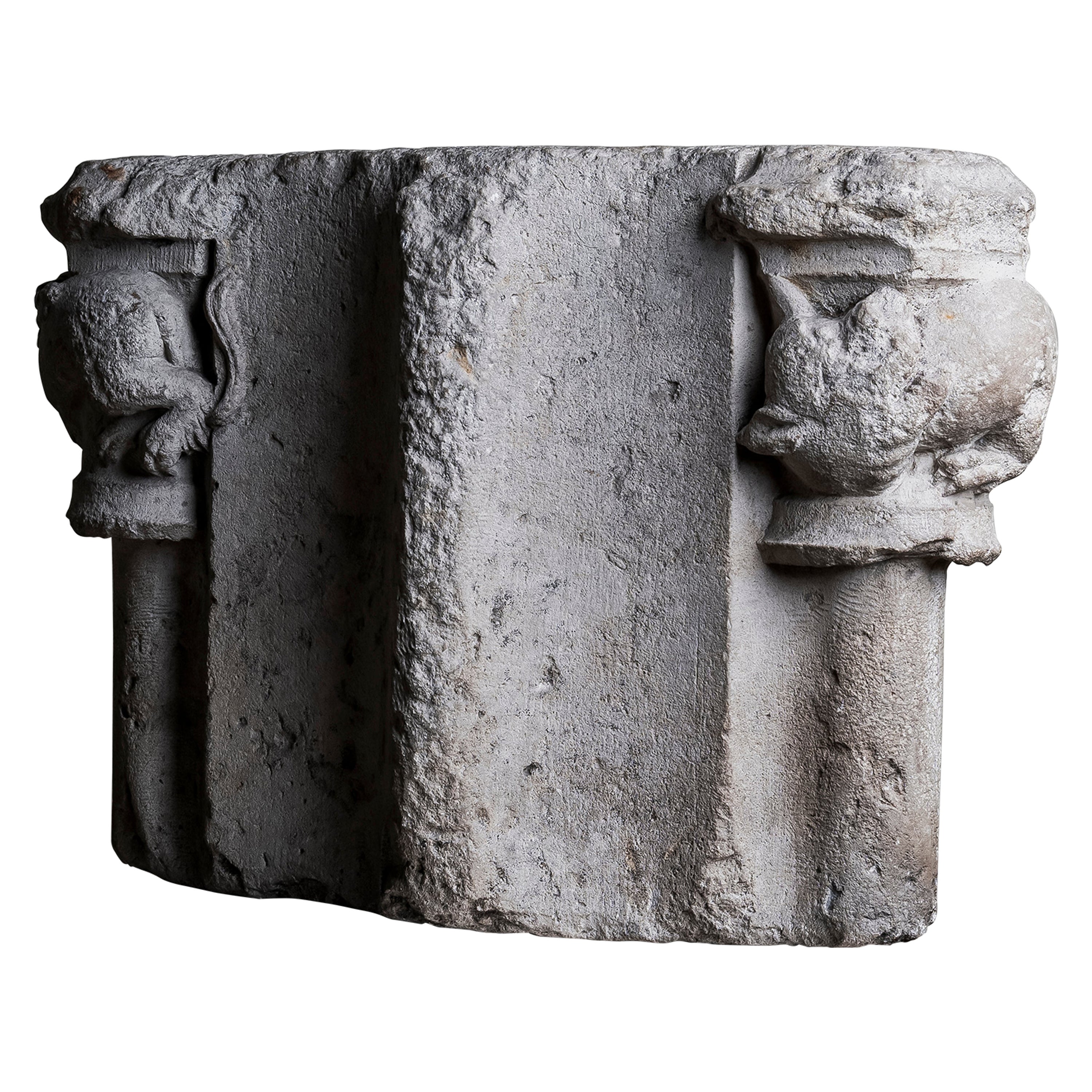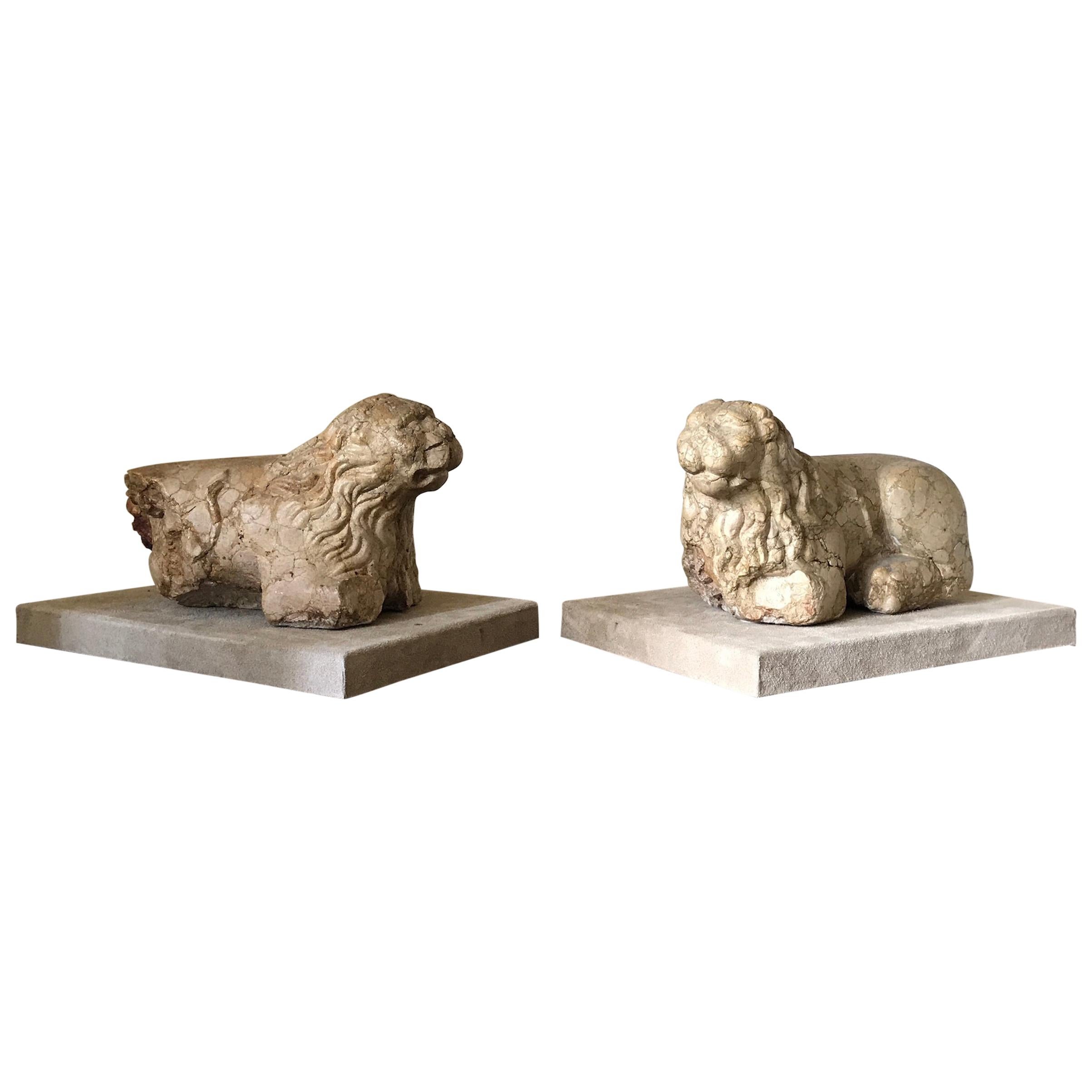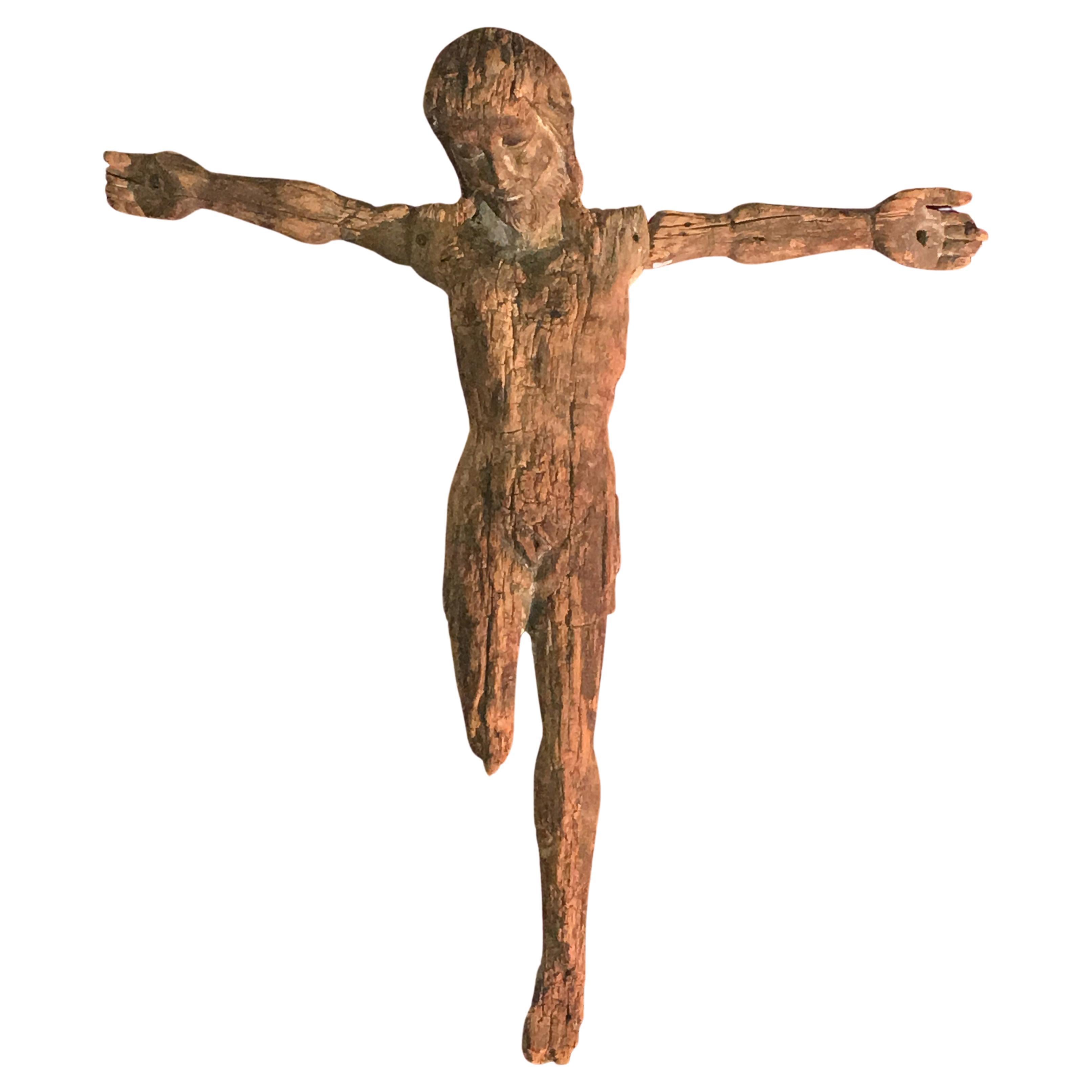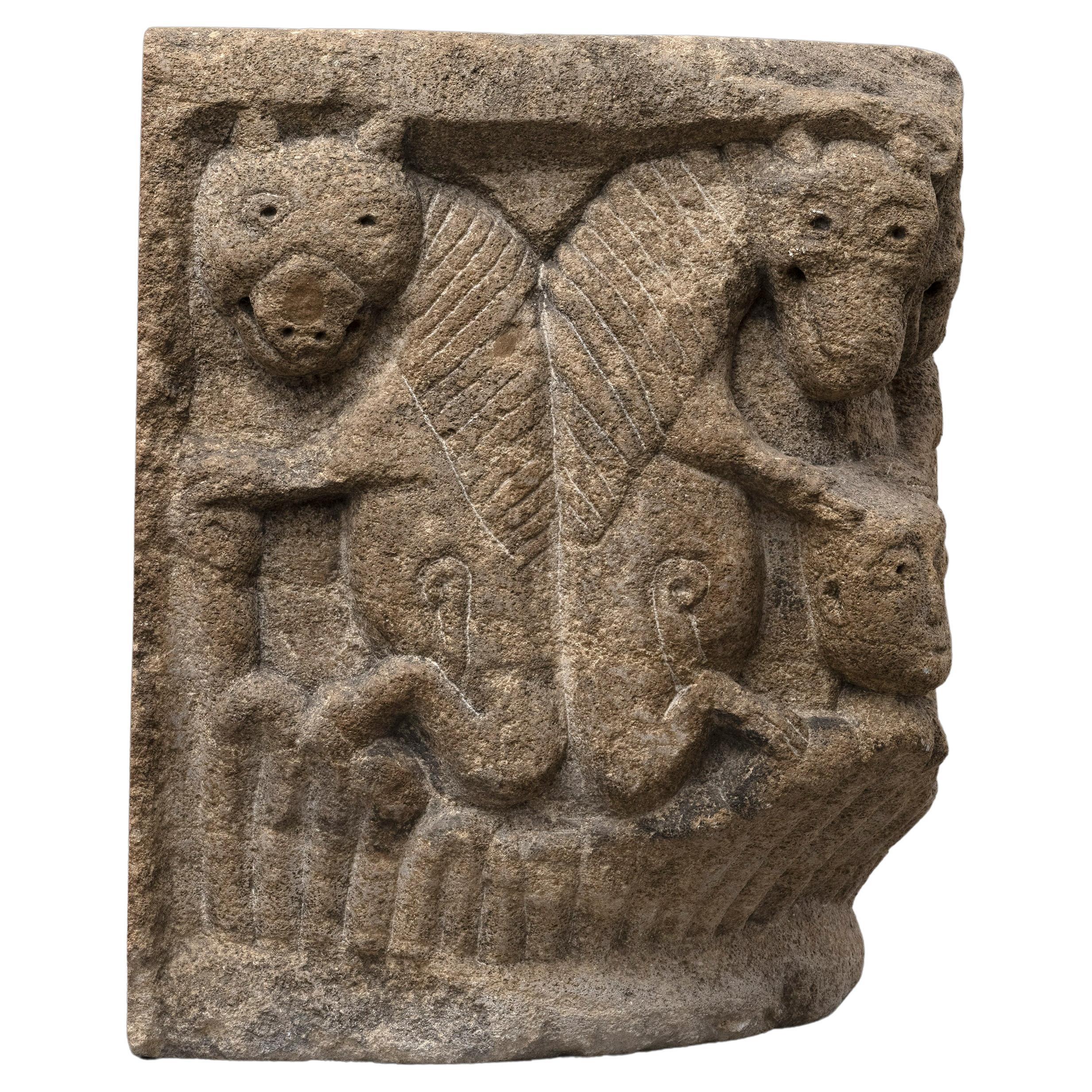Items Similar to Romanesque capital with sirens - France 13th century
Want more images or videos?
Request additional images or videos from the seller
1 of 7
Romanesque capital with sirens - France 13th century
About the Item
Rare romanesque capital with sirens
France, XIII century
Limestone
25 x 28 x 22 cm
This finely carved Romanesque capital, executed in high relief from limestone, features four hybrid figures resembling harpies (or sirens), positioned at the corners and interspersed with four coats of arms. The figures' bodies and heads occupy the corners, while their tails and coats of arms extend across the faces. An astragal, resembling a smooth reed, encircles the lower portion of the sculpted basket. Originally, the capital likely bore polychromatic decoration, with colors playing a pivotal role in distinguishing the coats of arms. The four identical figures exhibit facial features framed by wavy hair cascading over their ears, suggesting a dating to the latter half of the 13th century.
Arranged in opposing pairs, these hybrid creatures possess scaly tails and hoofed feet (as observed in the sirens of the Saint Loup-de-Naud capital). While they may be identified as harpies or sirens, the distinction between the two was often blurred in the Middle Ages. As Victor-Henri Debidour astutely notes, familiarity with such fantastical entities often led to ambiguity regarding their classification as chimeras, lamiae, or harpies. Romanesque sculptors approached their craft by selectively incorporating various details, often expressing personal preferences and artistic liberties, rather than adhering strictly to consistent characteristics for different mythical creatures. For instance, only sphinxes were traditionally depicted with wings and split hooves. In contrast, our sculptors did not adhere strictly to this convention, assigning split hooves to sirens akin to those of sphinxes.
The motif of bird or fish-headed figures had a longstanding history spanning four millennia before appearing on Romanesque capitals. During this extensive period, from Eastern origins to Roman production, the siren persisted as a recurring theme. Byzantine, Coptic, and Muslim art, inheriting Greco-Roman traditions, frequently depicted bird-headed figures. Additionally, the siren motif lent itself admirably to the constraints of Romanesque capital decoration, as the creature's flexible tail could be maneuvered to fit various architectural contexts. During the Romanesque era, sirens primarily adorned capital baskets and corbels, as exemplified in the present capital. The attraction to reptilian forms stemmed not only from a fascination with the symbolism of Evil but also from the ease of integration into architectural motifs. Thus, the siren represented an adaptation of ancient themes to the specific sculptural constraints of the Romanesque period.
Moreover, a notable innovation in Romanesque iconography was the frequent depiction of bird-sirens with serpent tails, a feature absent in preceding artistic traditions. Such a consistent inclusion of serpent tails suggests a deliberate symbolic significance attributed by Romanesque artists. Notably, the serpentine tail imbued the creature with a constant moral character associated with the serpent, universally recognized as a symbol of evil in medieval art. By endowing the siren with this stigmatized appendage, Romanesque artists intended to convey its pernicious nature and caution viewers against this dangerous entity. In the medieval imagination, the siren reclaimed its role as a cursed being from the Homeric era, and artists translated the symbolic interpretation assigned by clerics into stone, reminding viewers of the siren's association with human vice or as a manifestation of vice itself.
Before assuming its emblematic and symbolic significance, the medieval siren was initially regarded as an exotic creature. Its existence found validation not only in scriptural sources but also in accounts by ancient naturalists such as Pliny the Elder. Furthermore, mythographers and encyclopedists contributed to the gradual transformation of the siren from a mythical creature to a tangible entity, with mariners increasingly claiming sightings of these creatures.
During the 12th and 13th centuries, the siren was predominantly depicted as an amalgamation of human and animal characteristics, more akin to a fish with a human head than a woman with a fish's body. This portrayal is corroborated by its inclusion in bestiaries and its prominence within broader iconographic programs. The dual nature of the siren invites contemplation on the theme of hybridity, representing the transcendence of boundaries between humanity and animality, a prevalent motif in medieval art and thought.
The iconography and stylistic elements of the present capital exhibit striking similarities to those of a capital adorned with harpies housed at the Cleveland Museum of Art. Sharing nearly identical dimensions, these capitals share a common structural composition, delineated by a rounded astragal demarcating the lower portion and expanding into a quadrangular form adorned with an engraved frieze at the upper section. The depiction of harpies is consistent across both capitals, characterized by sinuous, scaly tails and hoofed feet. This distinctive portrayal of sirens as bird-fish hybrids, featuring serpentine tails, scales, and slender hooves, represents a unique architectural motif likely inspired by contemporary illustrated bestiaries. The presence of such similarities suggests that both works may have been crafted by the same hand or by artisans collaborating on the same project. Furthermore, the utilization of the same slightly pinkish limestone, characteristic of the Toulouse region, unequivocally identifies the origin of this capital, attributing its creation to the 13th century.
- Dimensions:Height: 9.85 in (25 cm)Width: 11.03 in (28 cm)Depth: 8.67 in (22 cm)
- Style:Medieval (Of the Period)
- Materials and Techniques:
- Place of Origin:
- Period:
- Date of Manufacture:13th century
- Condition:Wear consistent with age and use.
- Seller Location:Bruxelles, BE
- Reference Number:1stDibs: LU6666237118522
About the Seller
5.0
Vetted Seller
These experienced sellers undergo a comprehensive evaluation by our team of in-house experts.
1stDibs seller since 2022
6 sales on 1stDibs
Typical response time: 7 hours
- ShippingRetrieving quote...Ships From: Bruxelles, Belgium
- Return PolicyA return for this item may be initiated within 3 days of delivery.
More From This SellerView All
- Double Romanesque Capital, France, 13th CenturyLocated in Bruxelles, BEDouble romanesque capital decorated with two fantastic animals France, 13th century Measures: 26,5 x 38,5 x 14,5 cm. This rare double cap...Category
Antique 15th Century and Earlier French Medieval Architectural Elements
MaterialsStone
- Rare Romanesque Capital Depicting Four Africans, Apulia, 13th CenturyLocated in Bruxelles, BELarge stone capital carved on each side in strong relief. The basket is covered with two crowns of vertical acanthus leaves which sprout from the astragal and fill the space between ...Category
Antique 15th Century and Earlier Italian Medieval Architectural Elements
MaterialsStone
- Gothic Capital with Foliate Decoration, 13th CenturyLocated in Bruxelles, BEGothic capital with foliate decoration France, limestone 13th century 16.5 x 17 x 12.5 cm The leaves are organically arranged around the core of...Category
Antique 15th Century and Earlier French Medieval Architectural Elements
MaterialsLimestone
- Rare Romanesque Capital Representing Daniel in the Lion’s Den, 12th CenturyLocated in Bruxelles, BEEngaged Romanesque capital representing Daniel in the Lion’s den France, 12th century Limestone 38 x 29 x 18 cm Provenance : Private coll...Category
Antique 15th Century and Earlier French Medieval Architectural Elements
MaterialsLimestone
- Virgin and the Child, Mosan Region, Second Half of 13th CenturyLocated in Bruxelles, BEA polychrome sculpture depicting the Virgin and the Child Mosan region, second half of 13th century Polychrome wood 73 x 29 X 12 cm Provenance : Former Belgian private collection from the beginning of the 20th century This remarkable early artwork portrays the Enthroned Virgin and Child, also known as Sedes Sapientiae, which translates to the 'Seat of Wisdom...Category
Antique 15th Century and Earlier Belgian Medieval Figurative Sculptures
MaterialsWood
- Gothic Canopy, France, 15th CenturyLocated in Bruxelles, BEGothic canopy France, 15th century Alabaster, some traces of polychromy 33 x 23 x 20 cm Provenance: - Private collection Genève, Switzerland ...Category
Antique 15th Century and Earlier French Gothic Figurative Sculptures
MaterialsAlabaster
You May Also Like
- Lions Pair of Sculpture Marble Italian 13th Century RomanesqueLocated in BUNGAY, SUFFOLKRare, pair of 13th century, Romanesque, marble, recumbent lions Recumbent lions were popular in 11th-13th century Italian architecture with pairs ...Category
Antique 15th Century and Earlier Italian Classical Roman Animal Sculptures
MaterialsMarble
- 13th Century Virgin and Child from CataloniaLocated in Saint-Ouen, FRSeating on a bench-like throne the Virgin carries her child on her left knee. She bears an important crown high on her head .The Virgin has an ovoid face with bulging eyes, straight long nose and thin lips. The hair parts in the middle and are carved as thick horizontals parallel hair strands...Category
Antique 15th Century and Earlier Spanish Gothic Figurative Sculptures
MaterialsOak
- Rare 13th Century Christ on the CrossLocated in Saint-Ouen, FRThis wood Christ bears signs of time without diminishing its grace nor its interest. This Christ presents some characteristic of the previous century. While the feet are missing the position of his legs, parallel one to the other, let us think his feet where placed side by side as in the 12th century’s crucifix. The remains of his perizonium let us guess the cloth was very short, displaying the knees and a part of the thighs. The figure is straight, the arms horizontal, the hands open -with tha palm then pierced by nails- and the thumbs parallel to the other fingers as in most of the 12th century’s Christ on...Category
Antique 15th Century and Earlier French Gothic Figurative Sculptures
MaterialsWood
- Rare English Romanesque Limestone Capital on StandLocated in Wormelow, HerefordshireThis weathered English Romanesque limestone capital is centuries old, dating from the Norman era of the 11th and 12th centuries. Originating from Oxf...Category
Antique 15th Century and Earlier English Medieval Mounted Objects
MaterialsStone, Limestone
- Thai Lopburi Cast Bronze Seated Buddha, 13th CenturyLocated in Austin, TXA fine early Thai Lopburi figure of a crowned and adorned Buddha, cast bronze, mid-13th century. The unusual figure of the Buddha sits in virasana upon a stylized lotus pedestal. He is dressed in the traditional monastic robes, but also adorned with a crown and jewelry, including earrings, a necklace, and jeweled belt. His hands in an atypical combination of mudras. His right hand in bhumisparsha mudra, reaching down to touch the earth, while his left hand held somewhat outwards, seemingly in varada mudra, the gesture of granting favours or wishes. The palm of his outstretched hand marked with the dharmachakra, the Wheel of the Law, representing Buddhist teaching. The bronze with a beautiful silvery patina. Lopburi was an independent Mon kingdom with strong ties to the Khmer Angkor...Category
Antique 15th Century and Earlier Thai Sculptures and Carvings
MaterialsBronze
- Small Song Dynasty Carved Wood Bodhisattva, 13th Century, ChinaLocated in Austin, TXA small and very fine Chinese carved sandalwood figure of a bodhisattva, possibly Avalokiteshvara (Guan Yin), Song Dynasty (960 to 1276), circa 13th ...Category
Antique 15th Century and Earlier Chinese Sculptures and Carvings
MaterialsHardwood
Recently Viewed
View AllMore Ways To Browse
Carved Limestone Capital
Pair Of French Sculpture
Austin Sculpture By Fisher
Mercury Fortuna
Italian Chinoiserie Statue
Peter Keil Mannequin
Draped Furniture
Head Of The Warrior
Art Deco Erotic
Goldscheider By Lorenzl
Bronze Sculpture Sitting Woman
Plaster Sculpture On Sale
Flapper Bronze
H Dumaige Soldiers
Chalkware Plaques
Porcelain Figural Group Lace Figurines
Carved Jade Objects
Robe Statue





